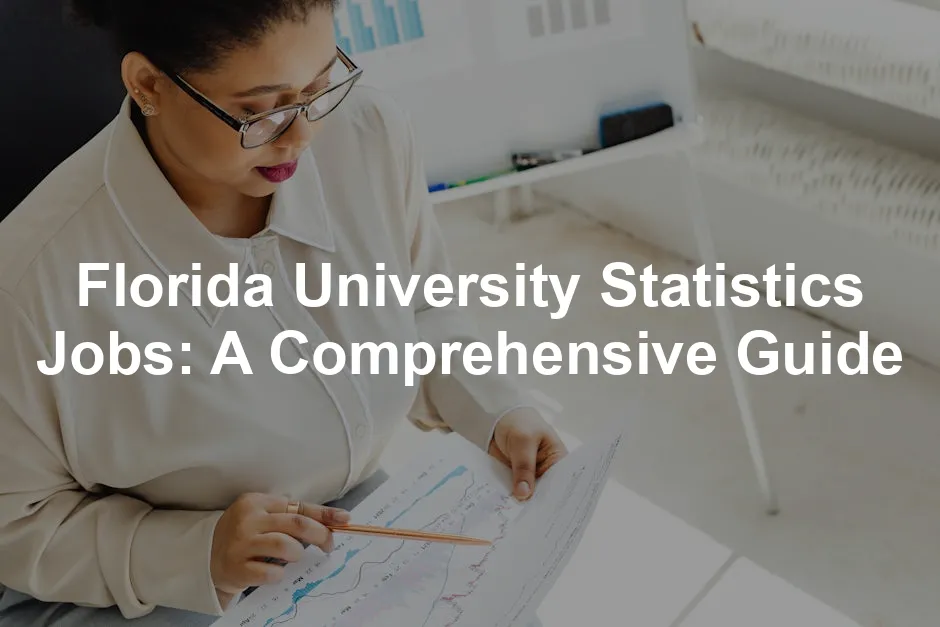Introduction
Statistics isn’t just a bunch of numbers; it’s the lifeblood of decision-making across various sectors. From healthcare analyzing patient data to finance forecasting market trends, statistics plays a vital role. In technology, it powers algorithms that drive artificial intelligence, making it indispensable in shaping our future.
Now, let’s not overlook Florida—a sunny paradise that’s also a hotbed for academic excellence and job opportunities in statistics. With esteemed institutions like the University of Florida and Florida State University, the state boasts a vibrant academic landscape. These universities not only offer robust statistics programs but also foster connections with industries eager for statistical talent.
The purpose of this article is to serve as your go-to guide for statistics jobs available in Florida universities. We’ll cover everything from job types to qualifications and the application process. Whether you’re a recent graduate or a seasoned professional, this guide aims to equip you with the insights needed to land that dream job in statistics.
Understanding the Landscape of Statistics Jobs in Florida
Overview of Statistics Careers
The field of statistics offers a wide array of career paths. You can choose to work in academia, industry, or government roles. Each path has its unique flavor. In academia, you might teach the next generation of statisticians or conduct groundbreaking research. Industry roles can range from data analyst to statistician, where you’ll apply your skills to solve real-world problems. Government positions often focus on public health or policy evaluation, providing essential insights that shape community welfare.
With the digital age in full swing, the demand for statisticians and data scientists is skyrocketing. Companies are drowning in data, and they need professionals who can turn that data into actionable insights. Statistics is not just a job—it’s a ticket to a thriving career in a data-driven world. So, if you’ve ever found yourself fascinated by numbers, now is the time to jump in!
If you’re looking to dive into the world of data science, you might want to check out Data Science for Dummies. This book breaks down complex concepts into bite-sized pieces, making it perfect for beginners eager to understand the data world.
For those interested in pursuing a career in statistics, there are numerous opportunities available. Check this comprehensive guide on sports statistics jobs.
In summary, Florida’s universities are brimming with opportunities for those passionate about statistics. Whether you’re eyeing a teaching role or a data-driven position in the private sector, the Sunshine State has something for you. Let’s dig into what specific job opportunities await you.
Major Universities and Their Programs
Florida is home to several prominent universities with outstanding statistics programs. Here’s a quick look at some of them:
- University of Florida (UF): Located in Gainesville, UF is the state’s oldest and largest university. Its Department of Statistics offers a range of undergraduate and graduate programs. They focus on areas like causal inference and statistical machine learning. With cutting-edge research facilities, UF is a leader in statistical education.
- Florida State University (FSU): FSU’s Department of Statistics is known for its robust curriculum and research opportunities. They offer both undergraduate and graduate degrees. The department emphasizes statistical theory, applied statistics, and data science. FSU actively engages in community projects, providing students real-world experience.
- University of Miami: This institution features a Department of Statistics that blends statistical education with practical applications. They offer various degrees, including a Ph.D. program that prepares students for academic and industry roles. The department focuses on biostatistics, which is particularly beneficial given Miami’s diverse healthcare landscape.
- University of Central Florida (UCF): UCF’s statistics program is designed to equip students with essential analytical skills. They offer a Master’s in Statistics, which covers various aspects of data analysis and statistical theory. UCF also provides opportunities for internships and collaborations with local industries.
- Florida Gulf Coast University (FGCU): FGCU offers a Bachelor’s degree in Mathematics with a concentration in Statistics. Their program emphasizes hands-on learning through projects and research. FGCU prepares students for careers in data analysis, finance, and other fields.
These universities play a pivotal role in shaping the future of statistics professionals in Florida, fostering both academic excellence and practical skills.
If you’re considering a deep dive into data visualization, you should check out Data Visualization: A Practical Introduction. This book is a fantastic resource that teaches you how to present data in a visually appealing way, making complex information digestible.
Types of Statistics Jobs Available
Academic Positions
The academic landscape offers a variety of roles for those interested in pursuing a career in statistics. Here’s a closer look at some key positions:
- Assistant Professors: This role is often a tenure-track position. Assistant Professors focus on teaching undergraduate and graduate courses while conducting research. They typically need a Ph.D. in statistics or a related field. Responsibilities may include mentoring students and publishing research findings. The path to becoming an Assistant Professor is competitive, but it’s rewarding for those who thrive in academia.
- Lecturers and Instructors: These positions are crucial in academia. Lecturers often focus primarily on teaching, delivering lectures, and creating course materials. Instructors may also engage in student advising and curriculum development. While these roles may not always require a Ph.D., a Master’s degree in statistics or a related area is usually necessary. Their significance lies in shaping students’ understanding of statistical concepts.
- Adjunct Faculty: Adjunct faculty positions offer flexibility for professionals looking to teach part-time. These roles are often filled by individuals already working in the field, bringing practical experiences into the classroom. Adjunct positions can be found at many universities, and the requirements generally include at least a Master’s degree in statistics or a closely related field. This role is perfect for those who want to share their knowledge while pursuing other professional commitments.
In conclusion, academic positions in Florida’s universities provide various opportunities for individuals passionate about statistics. From tenure-track roles to part-time teaching, there’s something for everyone. Whether you’re just starting or looking to advance your career, these academic roles are stepping stones toward a fulfilling career in statistics.
As you explore these academic opportunities, consider enhancing your skills with Practical Statistics for Data Scientists: 50 Essential Concepts. This book covers critical statistical concepts necessary for data-driven decision-making, ensuring you’re well-prepared for your academic journey.
Research Positions
In the realm of statistics, research positions play a crucial role. They drive innovation, inform public health initiatives, and shape policy decisions. Think of research associates, postdoctoral researchers, and biostatisticians as the superheroes of data. They wield numbers like magic wands, uncovering insights that can transform lives.
Research associates typically assist in ongoing projects. They gather data, conduct analyses, and help interpret results. With a keen eye for detail, these professionals ensure accuracy while supporting senior researchers. Postdoctoral researchers, on the other hand, often work independently. They dive deep into specific areas, contributing original discoveries to the field.
Biostatisticians focus on applying statistical methods to health-related issues. They analyze data from clinical trials and epidemiological studies, providing insights that guide healthcare practices. Their work can lead to groundbreaking findings, influencing everything from disease prevention to treatment efficacy.
The importance of research in advancing the field cannot be overstated. It contributes to community health and informs public policy. By addressing pressing issues through rigorous analysis, these professionals help create healthier societies. In a world where data drives decisions, their role is vital.
Industry and Government Jobs
While academic roles are significant, the job market extends far beyond university walls. Industry and government positions offer diverse opportunities for statisticians. Here, you can find yourself working in healthcare, finance, or public health sectors.
In healthcare, roles such as data analysts and biostatisticians are in high demand. These professionals work with patient data to improve health outcomes. They analyze trends, identify risk factors, and support clinical decision-making. Similarly, in finance, statisticians help firms make data-driven investment decisions. They model financial risks and forecast market trends, ensuring companies stay ahead.
Public health sectors also seek skilled statisticians. Roles like statistician and data scientist are essential in designing studies and evaluating health programs. These professionals help governments understand health trends and allocate resources effectively.
For those eager to branch out from academia, these industry and government positions provide exciting avenues. With a mix of analytical skills and practical application, statisticians can significantly impact various fields. Whether you prefer the fast pace of finance or the mission-driven work in public health, opportunities abound.
Key Skills
If you want to thrive in statistics jobs, certain skills are essential. First, proficiency in statistical software is crucial. Tools like R, SAS, and Python are your best friends. They help you analyze data, conduct simulations, and visualize results. Familiarity with databases and data manipulation software is also valuable.
Next up is data analysis. You’ll need to interpret complex datasets and draw meaningful conclusions. Being detail-oriented is a must; after all, one misplaced decimal can throw off your entire analysis. Critical thinking is equally important. You must evaluate problems from multiple angles and propose effective solutions.
Now, let’s not forget communication skills. Statisticians often present their findings to people who might not speak “data.” Clear, concise communication helps you share complex statistical concepts in an understandable way. Whether it’s through reports, presentations, or discussions, your ability to convey ideas effectively can set you apart.
To enhance your communication and technical abilities, consider checking out The Art of Statistics: Learning from Data. This book provides insightful perspectives on statistical concepts, helping you present your findings in a more relatable way.
Job Application Process
Preparing Your Application
Crafting a strong application is your first step toward landing a statistics job. Start with your CV. Tailor it to highlight relevant experience and skills. Avoid generic statements; instead, focus on specific projects that showcase your statistical prowess. Use action verbs and quantify your achievements—numbers grab attention!
Next, your cover letter should complement your CV. It’s your chance to explain why you’re the perfect fit for the position. Mention specific skills or experiences that align with the job requirements. Show enthusiasm for the role and the institution. Remember, a good cover letter adds a personal touch to your application.
A strong portfolio is also crucial. It should showcase your work, from academic projects to real-world applications. Include case studies, research papers, and any relevant reports. Visuals can enhance your portfolio, so consider adding graphs or charts that illustrate your findings. This not only demonstrates your technical skills but also your ability to present data effectively.
Lastly, ensure your online presence reflects your expertise. LinkedIn is a great platform to connect with professionals in your field. Share articles, engage in discussions, and showcase your projects. A strong online presence can open doors and present you as a knowledgeable candidate. For more insights on using LinkedIn effectively, check out this guide on medivation statistical programming linkedin.
In summary, a well-prepared application can significantly improve your chances of landing an interview. Focus on crafting an impressive CV and cover letter, and don’t forget to build a strong portfolio that showcases your skills. With these elements in place, you’ll be well on your way to securing that coveted statistics job!
To further bolster your application, consider brushing up on statistical methods with Statistical Methods for the Social Sciences. This book provides a comprehensive overview of essential statistical techniques that can enhance your understanding and application of data analysis.
Networking and Job Search Strategies
Networking is your secret weapon in the statistics job market. It opens doors and connects you with like-minded professionals and industry insiders. Attend academic conferences, workshops, and local meetups. These events are gold mines for making connections that can lead to job opportunities. Don’t forget to engage with professors and alumni; they often have insights and leads on job openings.
Online platforms also play a crucial role in networking. LinkedIn is where many professionals showcase their skills and connect. Join relevant groups, participate in discussions, and share your insights. Twitter can also be a surprising ally. Follow statisticians and institutions, and you might just stumble upon job postings and industry news.
When it comes to job searching, utilize all available resources. University job boards are a fantastic starting point. Institutions like the University of Florida and Florida State University frequently post openings. Also, check professional organizations, such as the American Statistical Association, which often feature job listings. For more information on career opportunities in this field, visit american statistical association jobs.
Remember, a proactive approach is key. Set up Google Alerts for specific job titles, and follow relevant hashtags on social media. This way, you’ll be among the first to know about new openings.
Current Job Listings and Opportunities
Recent Job Openings
- Assistant Professor in Statistics
Location: University of Florida, Gainesville, FL
Description: Seeking candidates with a Ph.D. in statistics, computer science, or related field. Responsibilities include teaching and conducting research in areas like causal inference and statistical machine learning. Apply here. - Tenure Track Assistant Professor of Mathematics
Location: Embry-Riddle Aeronautical University, Daytona Beach, FL
Description: This position focuses on teaching and research in mathematics. A competitive salary is offered. View details. - Adjunct Faculty, Mathematics
Location: Florida Gulf Coast University, FL
Description: Part-time teaching role in mathematics. Ideal for professionals seeking flexible teaching opportunities. View details. - Research Biostatistician
Location: University of Miami/UHealth Division, FL
Description: Seeking a biostatistician to support various research projects. Familiarity with SAS programming is a plus. View details. - Postdoctoral Researcher
Location: Brown University, Providence, RI
Description: Focused on biostatistics with an emphasis on clinical trials. Ideal for candidates looking to deepen their research experience. View details. - Adjunct Assistant Professor, Mathematics
Location: Santa Fe College, Gainesville, FL
Description: A part-time role aimed at teaching mathematics courses. Competitive pay per semester credit hour. View details. - Teaching Assistant Professor
Location: University of Pittsburgh, PA
Description: This role emphasizes teaching and student engagement within the statistics department. View details.
These positions highlight the diverse opportunities available in Florida’s academic and research institutions. Each role offers unique responsibilities and the chance to contribute to the field of statistics.
As you consider these opportunities, don’t forget to prepare yourself with the right resources. A great starting point is The Data Science Handbook, which provides an overview of essential skills and knowledge for aspiring data scientists.
Job Alerts and Resources
Setting up job alerts is a great way to stay ahead of the game. Most job platforms, including HigherEdJobs and Indeed, allow you to create alerts based on your specific criteria. Simply enter keywords like “statistics” or “data science” and choose your preferred locations. You’ll receive notifications whenever new positions are posted, ensuring you never miss an opportunity.
Additionally, follow university job boards regularly. The University of Florida and other institutions often update their listings. Consider subscribing to newsletters from professional organizations like the American Statistical Association. They frequently share job openings and industry news, keeping you informed about trends and opportunities in the statistics field.
Don’t underestimate the power of social media in your job hunt. Twitter and LinkedIn are valuable tools for job seekers. Follow relevant hashtags and organizations that post job opportunities. Engaging with the community can lead to unexpected openings and connections.
With these strategies in place, you’ll be well-equipped to navigate the job market in statistics. Stay proactive, keep your network alive, and stay informed. The opportunities are out there just waiting for you to seize them!
Please let us know what you think about our content by leaving a comment down below!
Thank you for reading till here 🙂








All images from Pexels




